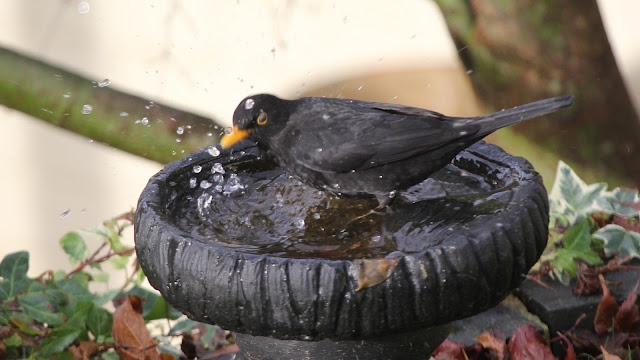As the sun came up the garden became busy. The apples I had put out a few days ago were all gone, so the trees were replenished, and almost immediately were set upon by the blue tits. The blue tits were also active in the tree outside my office, this one looking quite quizzical.
As I watched them pulling apart the lichen on the branches I noticed that one looked quite familiar. The area around the eye was bare of feathers, and I have to assume this is the same bird we had seen at he beginning of the year, while the feathers did not seem as bare, they did show the same pattern. Once again the bird we came to call "Richard", seemed not to be bothered by this, and even came to the feeder just outside the office window.
In the back garden the female Blackcap was back, slipping slowly through the tree towards the apples. She is still very wary of the other birds, but usually by the end of the winter they are quite up to standing up for themselves.
I have removed the dishes from below the feeders because the pigeons and doves were using them to both hog, and eat all the seed. There is one small feeder that still has one though, because I use this for the mixed seed. This Wood Pigeon was determined to use the feeder though despite the fact it was far to big to fit on. It some how managed to hang on the dish, and twist its head to get at the seed.
At lunch time I set off for a walk through Old Down Wood. I parked at the pond which was frozen, and without the fallen tree. The entrance to the wood was very muddy and wet, and as I walked though it, I disturbed a group of Blackbirds feeding in the leaf litter. A Robin also appeared and seemed to watch me as I walked through the mud and leaves, probably waiting to see if I would turn over anything interesting to eat.
I walked around the southern perimeter track, and there were a few Blackbirds again on the path, but also quite a few Song Thrushes and the odd Mistle Thrush. The wood was very quiet as I made my way around the path, and then into the centre, with only the song of the robins to be heard.
From the centre of the wood, I walked back towards Old Down cottage, just beyond the beech tree I heard a tit call, and was pleased to see a Marsh Tit in the bramble. It didn't stay long, and was quickly off across the path. I decided to wait and see if it would reappear, and tried "pishing" to see if that would attract it. The Marsh Tit didn't show again, but many others did. First was a party of Long-tailed Tits, hanging in the larch branches calling continuously. Against the sky they were difficult to photograph, this one looks like a fluffy pink blob.
Next were the goldfinches, quickly followed by a group of Siskins, the first ones I had seen in the wood since April. They were very busy feeding on the larch cones, hanging upside down in an attempt to get to every possible seed.
There were also a few Chaffinches about, and when I saw a flash of red I assumed it was a chaffinch, but it looked and behaved differently so I decided to get a closer look and was very pleased to find it was in fact a male Crossbill. I had only heard them at the start of the year, both here and in Lord's Wood, so I was very pleased to finally see them, and best of all get some pictures. I counted in total six birds, two splendid red males and 4 females.
I watched the crossbills for quite awhile, then realised I had better get back. I made my way out of the wood, again watched by the robin as I walked through the muddy bit. I decided to have a quick walk around the pond, just to see if the cold weather had brought in a woodcock, but it hadn't. The tree that had fallen last week, had been cut up and moved, but the stump was there and it was possible to see the age rings. I estimated that the tree must have been around 140 to 150 years old, incredible.
As I drove home and passed the school I noticed a Kestrel sitting in the tree at the bottom of Alton Lane. It was in perfect light, and seemed quite at ease. I managed to get quite close, and with the angle from below the branch I was able to get some lovely photos.
A little later I noticed a superb male Bullfinch on the feeder, I did get a few shots of it on the feeder, but it flew off, and then fortunately landed in the honeysuckle, and again I had the chance to capture it in the open.
Waxwing Update: They have been seen in Winchester, Badshot Lea, and Eastleigh. They have also been reported from Sussex and Surrey. The trees are loaded with apples, I just hope they see them.
I have also posted some pictures and updates from a recent trip to the Azores here.












.jpg)



























































